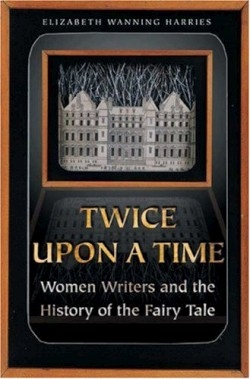
Twice Upon a Time
Women Writers and the History of the Fairy Tale
Writing about storytelling is itself a form of storytelling. Acknowledging this, and granting that “anyone who writes about revising stories must be acutely conscious that the story she is telling is one of many possible versions,” the author goes on to explore every aspect of the fairy tale genre, from its origins, through its role in the oral tradition and the canon of literature, to its resurgence in popularity.
Explaining the definition of the fairy tale, Harries, an associate professor of English and Comparative Literature at Smith College, dismisses the notion that they are “universal,” “classic,” or “offering insight into universal human dilemmas that span differences of age, culture and geography.” Instead, she reminds readers that the tales enjoyed over the ages were not static, but have been and continue to be “rewritten, printed and reprinted over centuries.” She asserts that “the history of fairy tales is not primarily a history of oral transmission but rather a history of print,” continued into the present day.
Women’s role in the history of the fairy tale is intriguingly discussed. According to Harries, the fairy tale itself has feminine attributes, beginning with the epithet “old wives’ tale,” which is meant to discredit not only the information the form conveys, but the source: women. Harries quotes Trinh Minh-ha, in her book Woman, Native, Other, who credits women for the transmission of stories with the metaphor of the maternal: “The world’s earliest archives or libraries were the memories of women. Every woman partakes in the chain of guardianship of transmission.” Continuing the tradition, contemporary women authors have successfully employed the fairy tale motif to portray present-day human preoccupations.
Included in this handsome volume are fifteen reproductions of original engravings from artists such as Albrecht Dürer, depicting scenes from folk and fairy tales. There are also useful notes, a bibliography, and an index.
In one of the book’s well chosen epigraphs, Angela Carter states: “Reading is just as creative an activity as writing and most intellectual development depends upon readings of old texts. I am all for putting new wine in old bottles, especially if the pressure of the new wine makes the bottles explode.” Harries’s new take on an old form is an important contribution to the study of the old form and the creation of the new.
Reviewed by
Michelle Reale
Disclosure: This article is not an endorsement, but a review. The publisher of this book provided free copies of the book to have their book reviewed by a professional reviewer. No fee was paid by the publisher for this review. Foreword Reviews only recommends books that we love. Foreword Magazine, Inc. is disclosing this in accordance with the Federal Trade Commission’s 16 CFR, Part 255.
